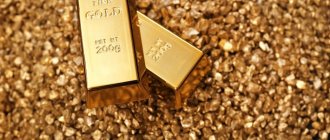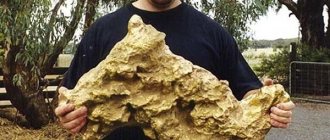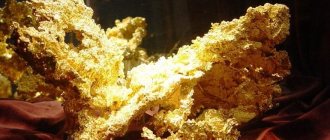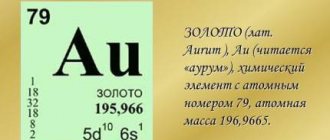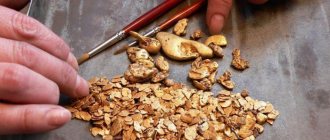Brief description of platinum
Editorial
Promdevelop editorial team
Platinum is a chemical element, a metal (platinum formula - Pt), and, moreover, a very rare one.
- Catalysts
However, this does not negate its wide range of applications - from jewelry to pacemakers. Platinum is a precious metal that is part of the so-called transition group, joining gold, silver and copper. Due to its atomic structure, platinum is able to easily bond with other elements.
What does platinum look like in nature?
In deposits, this metal is found in the form of granular formations of steel, silver with a white or yellowish tint, depending on the composition of the substance.
There are large platinum nuggets weighing up to 9 kilograms. Small cubic crystals are found much less frequently.
Pure substances are practically never found in nature; more often they are present in rocks in the form of various alloys.
Chemical and physical properties
This element belongs to the noble metals, since it is inert towards most known acids and alkalis:
- At room temperature it reacts with aqua regia.
- It is dissolved by liquid bromine and heated sulfuric acid of high concentration, but the reaction proceeds slowly.
Platinum is capable of creating hundreds of complex compounds, which makes it one of the most active catalysts for chemical reactions, while its composition remains unchanged.
This metal has a high density - a cube with sides measuring 1 cm will weigh 21-21.5 grams.
This is a refractory substance, its melting point is 1768 ° C, while it is very plastic, malleable and can be easily forged.
The process of formation in nature
The main theory is that the platinum group elements were formed during a colossal cosmic explosion and were in a molten state in the substance that later turned into the core of our planet.
Canada, about 5 tons, 2011 - 5th place
Canada, about 5 tons, 2011 - 5th place
The North American Palladium company and the Sudbury Vale company from Canada offered about 6 tons of platinum to the world market. Last year was a year of growth for NAP, when it was able to process 1.7 tons of non-ferrous metal ore, but for Val the time was not very successful. The Canadian company Sudbury Vale sharply lost its position in 2011. From almost 3 tons, the supply of platinum fell to 1.7 tons. Indicators for palladium also collapsed. The most common reason cited was the death of one of the workers at the mine in Sudbury, which led to a shutdown of production.
How are platinum veins found?
Such veins were often found in streams, on the banks of rivers, and also in places where other minerals were mined.
In Russia, platinum was discovered in the Urals and was considered an admixture with gold in placer mines. But due to its refractoriness, this metal did not find use for a long time and was simply thrown away or sent to waste dumps.
Satellites of platinum
As a rule, this metal is never found separately. His constant companions are:
- iron;
- rhodium;
- ruthenium;
- palladium;
- iridium;
- osmium.
Rarer satellites are nickel and copper.
Where is platinum found in nature?
This metal is mined mainly in complex deposits. It looks like a heap of small particles and ingots. The platinum vein, like gold, can be found in typical igneous igneous rocks.
Types of deposits
The deposits in which this element is mined are of two types:
- indigenous (primary);
- loose (secondary).
In primary deposits, platinum, along with other platinum group metals, is obtained as a by-product from the mining of sulfides, copper and nickel. There are vein inclusions in the rock that go deep into the earth's crust.
Placers are the result of the destruction of a bedrock deposit and are often located at a short distance from it. Here ingots and small particles in the form of sand and flakes or plates are mined.
This element is very rarely found in quartz vein formations.
Extraction methods
Placers are developed by washing soil containing precious metal. Heavy particles settle to the bottom, and waste rock is washed away with water. Platinum obtained from alluvial deposits is called raw.
In complex deposits, the main source of platinum is the slurry remaining after the extraction of nickel and copper from ore. The sludge is subjected to additional processing - roasting and repeated electrolysis. After which the content of precious metals in such ore reaches 60% of the total mass.
The method of subsequent purification (refining) is also used for raw platinum. It consists of double treatment of the substance with aqua regia, and then calcination at a temperature of 800 to 1000 °C.
Production volumes
Today, the total world production of platinum is about 184 tons per year. About 60 more tons of precious metal are obtained as a result of processing.
Main stages and methods of production
Metal mining always consists of sequential operations: opening the deposit, loosening and delivering rocks to the processing plant, obtaining raw platinum and purification (refining) work.
Depending on how and where platinum originated, methods of its extraction are chosen: open or closed. Each of them has its own characteristics.
Platinum is collected by open-pit mining in secondary deposits where the metal has been accumulating for some time. The first step is to remove the top layer of soil, under which the platinum deposits are buried. Next, using special equipment for working in quarries, rock with platinum included in it is mined. The resulting metal is sent for further processing.
Platinum is extracted using a closed method from a primary deposit. It is there that most of the raw materials that make up copper-nickel ores are contained. To extract precious metals, special mines are built in which miners manually drill holes in the rock, lay explosives and undermine the mine layers. The separated specimens are transported to the mine shaft and removed to the surface.
The closed method of platinum mining involves a lot of manual work carried out by hired workers. Although technology does not stand still and is increasingly using low-profile drilling equipment and conveyors that can function in low mines.
After opening the platinum strata, the rock goes through an enrichment stage. It is crushed, freed from foreign materials and sent for washing. At this stage, the raw material is saturated with water and air. This is necessary so that the platinum particles are detached from other components and float to the surface under the influence of air bubbles.
The separated platinum is removed and dried. This is how raw material with a precious metal content of 75-90% is obtained. The next step is cleaning.
Refining (purification) of platinum makes it possible to obtain pure material, free of foreign impurities. The procedure is carried out in factories using special equipment and certain technologies. As a result of complex thermochemical reactions, 6 platinum group metals are released. In addition, gold and silver, sometimes contained in platinum-containing ores, may “float up”.
Having completed all stages, from mining to final purification, platinum containing 99.95% of the precious metal is obtained. It is usually immediately melted down into ingots, granules, or left in powder form. The time from mining the ore to obtaining the pure metal typically ranges from 6 weeks for palladium and up to 20 weeks for rhodium. The time for transporting raw materials is not taken into account.
Areas of application
Recently, platinum has been widely used:
- In the automotive industry, in particular in the production of catalytic exhaust gas converters. The alloy is used in electronics to create high-precision and optical devices.
- In the petrochemical industry, this metal is necessary to create high-octane gasoline, rubber, the vast majority of monomers and other synthetic materials.
- In medicine, this element is used to create devices and tools. Platinum is necessary in the production of hydrogen peroxide, antibacterial and antiviral drugs. It is also used in the treatment of cancer.
- The space program and nuclear energy cannot operate without platinum. All of the above industries absorb about 60% of the precious metal.
- About 30% of precious metal is consumed in the manufacture of jewelry.
- The remaining 10% serves as a source of financial investment.
USA, about 6 tons, 2011 – 4th place
USA, about 6 tons, 2011 – 4th place
The Stillwater Mining Co monopoly is now the only company that deals specifically with platinum group metals, having made them its main supply product. The company owns two mines in Montana, Stillwater and East Bouder, where most of the platinum is mined. In 2011, mines produced 7% more platinum than in the same period last year. The company is continually investing in the Graham Creek project to gain access to additional resources and expects to complete it within a few years. , on the contrary, lost its position. She works with deposits of precious metal that are more than half a century old, which suggests that their resource has greatly depleted itself.
The richest deposits
South Africa has the richest reserves of platinum on the planet, and the largest deposit of all currently existing is also located there.
In the world
The most famous and promising mines today:
- Merensky Reef, South Africa;
- Great Dike, Zimbabwe;
- Stillwater, USA;
- Lac Deux Iles, Canada;
- Sudbury, Canada.
In Russia
The world's largest alluvial platinum deposit (Conder) is located in Russia.
Metal mining is carried out mainly in the Khabarovsk Territory, Kamchatka and the Sverdlovsk Region. The following deposits are especially noteworthy:
- Norilsk group, Krasnoyarsk region;
- Fedorova Tundra, Murmansk region;
- Conder, Khabarovsk Territory;
- Lobva, Sverdlovsk region;
- Levtyrinyvayam, Kamchatka;
- Vyysko-Isovsky, Sverdlovsk region.
Experts also highly appreciate the proven reserves that are located in Karelia, the Kola Peninsula and the Voronezh region.
All platinum mined on the territory of the Russian Federation falls on the share of MMC Norilsk Nickel. It is also one of the largest PGM producers in the world.
Price per 1 gram today
Currently, the demand for platinum is growing steadily, mainly due to the automobile industry. Daily platinum quotes on the exchange are available to our visitors online.
Platinum | RUB | 1 Gram
USDRUB*PL1!*10000000/311034768 chart provided by TradingView
Platinum | USD | 1 Gram
Chart PL1!*10000000/311034768 courtesy of TradingView
Platinum | RUB | 1 oz
USDRUB*PL1 chart! provided by TradingView
Platinum | USD | 1 oz
Schedule PL1! provided by TradingView
You can also take consolidated data from the interactive table.
What else can you sell on the “market”
Anything, really. In the main section you can sell mods (for example, rare ones from the Orokin Vault), hidden rift mods, Requiem mods, Kuva Lich ephemera, mystifiers, etc.
Also pay attention to the “Auctions” section (top right). Here you can trade rift mods and even Kuva Liches!
The rest is up to you. The faster you can farm items, the more you will earn. Now you have all the necessary information - you and the cards are in your hands. Good luck!
If you have something to say on the topic, do not hesitate to write comments. Tens of thousands of our readers will see them.

